Effective BIM and Knowledge Management for Construction Projects
VerifiedAdded on 2020/02/19
|17
|4143
|293
Report
AI Summary
This report delves into the application of Building Information Modeling (BIM) and Knowledge Management (KM) within the construction industry. It explores how BIM serves as an effective tool for knowledge management, enhancing communication, collaboration, and coordination among project stakeholders. The report outlines a conceptual framework for BIM, detailing procedures for its deployment and highlighting its benefits, such as improved product performance and efficient information access. It also addresses the challenges associated with BIM implementation. The report further examines how BIM facilitates various aspects of knowledge management, including information gathering, quantification, monitoring, and validation, ultimately leading to improved project outcomes and increased efficiency. The report provides detailed information about the role of BIM in construction activities. It also mentions the phases and activities of the construction process, from pre-construction to post-construction, and how BIM tools and technologies can be effectively used in each stage. The document concludes by emphasizing the significance of BIM and KM in transforming infrastructure projects and improving overall construction practices.

Integrated Information Project Management
Paraphrase This Document
Need a fresh take? Get an instant paraphrase of this document with our AI Paraphraser
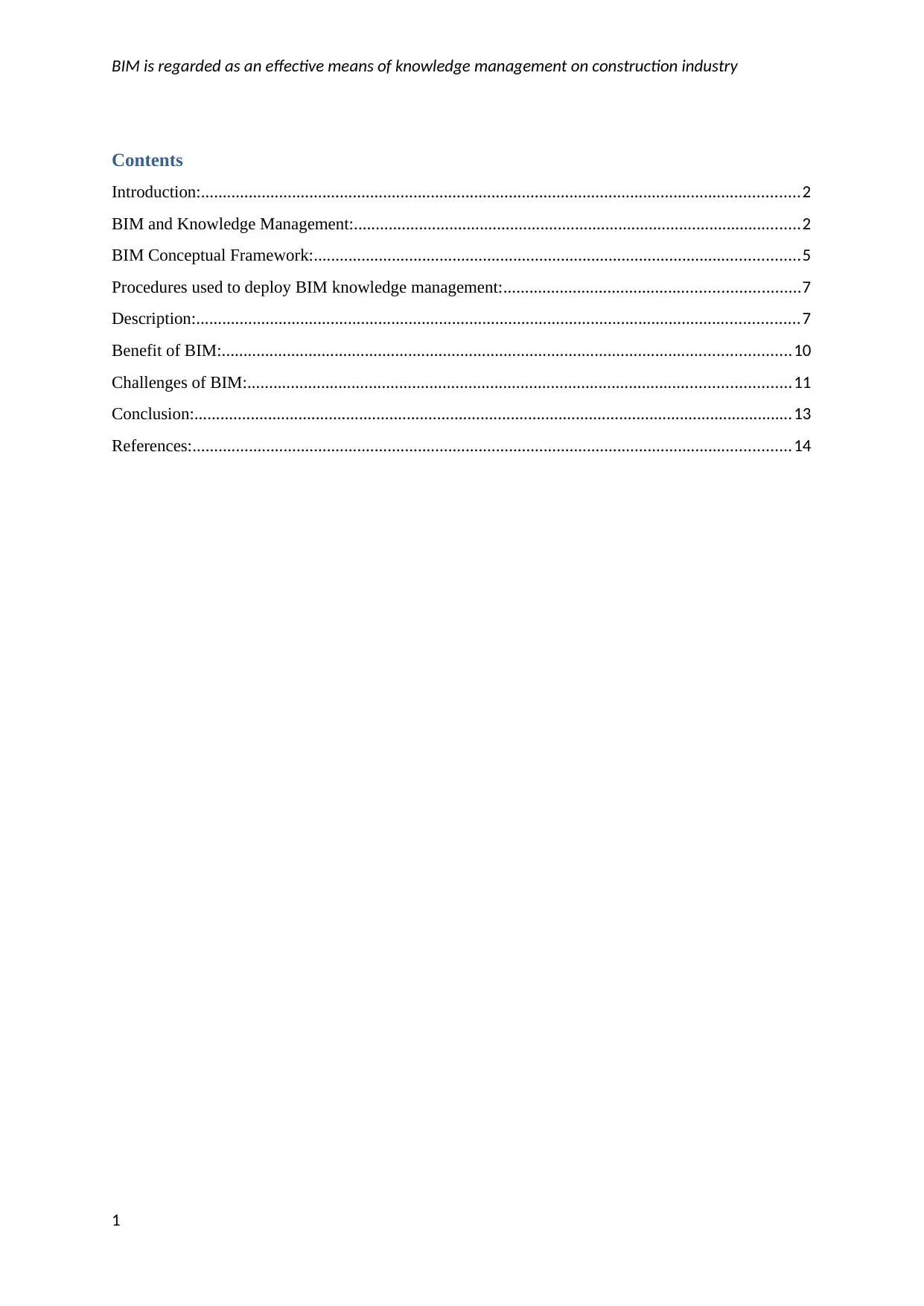
BIM is regarded as an effective means of knowledge management on construction industry
Contents
Introduction:..........................................................................................................................................2
BIM and Knowledge Management:.......................................................................................................2
BIM Conceptual Framework:................................................................................................................5
Procedures used to deploy BIM knowledge management:....................................................................7
Description:...........................................................................................................................................7
Benefit of BIM:...................................................................................................................................10
Challenges of BIM:.............................................................................................................................11
Conclusion:..........................................................................................................................................13
References:..........................................................................................................................................14
1
Contents
Introduction:..........................................................................................................................................2
BIM and Knowledge Management:.......................................................................................................2
BIM Conceptual Framework:................................................................................................................5
Procedures used to deploy BIM knowledge management:....................................................................7
Description:...........................................................................................................................................7
Benefit of BIM:...................................................................................................................................10
Challenges of BIM:.............................................................................................................................11
Conclusion:..........................................................................................................................................13
References:..........................................................................................................................................14
1
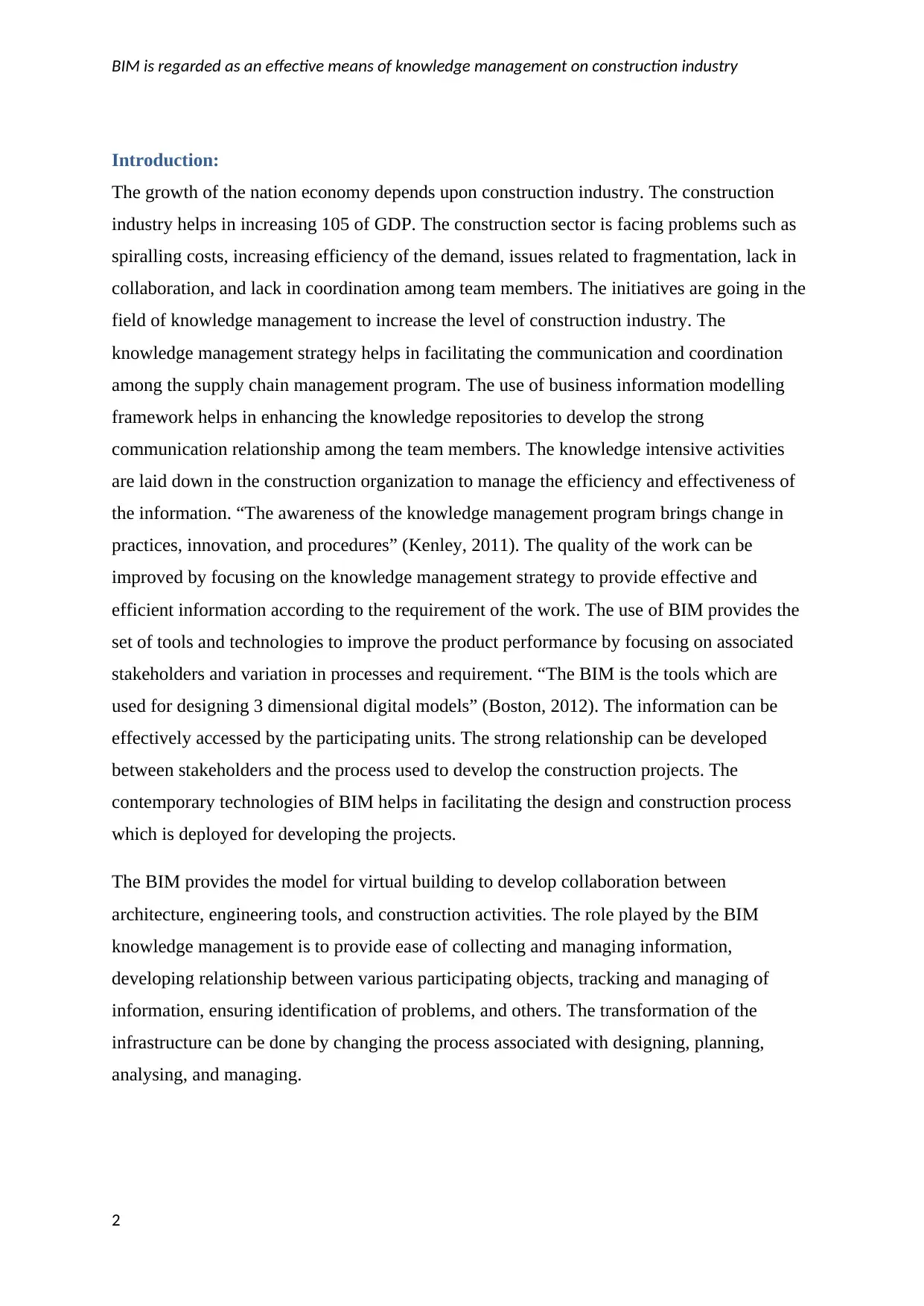
BIM is regarded as an effective means of knowledge management on construction industry
Introduction:
The growth of the nation economy depends upon construction industry. The construction
industry helps in increasing 105 of GDP. The construction sector is facing problems such as
spiralling costs, increasing efficiency of the demand, issues related to fragmentation, lack in
collaboration, and lack in coordination among team members. The initiatives are going in the
field of knowledge management to increase the level of construction industry. The
knowledge management strategy helps in facilitating the communication and coordination
among the supply chain management program. The use of business information modelling
framework helps in enhancing the knowledge repositories to develop the strong
communication relationship among the team members. The knowledge intensive activities
are laid down in the construction organization to manage the efficiency and effectiveness of
the information. “The awareness of the knowledge management program brings change in
practices, innovation, and procedures” (Kenley, 2011). The quality of the work can be
improved by focusing on the knowledge management strategy to provide effective and
efficient information according to the requirement of the work. The use of BIM provides the
set of tools and technologies to improve the product performance by focusing on associated
stakeholders and variation in processes and requirement. “The BIM is the tools which are
used for designing 3 dimensional digital models” (Boston, 2012). The information can be
effectively accessed by the participating units. The strong relationship can be developed
between stakeholders and the process used to develop the construction projects. The
contemporary technologies of BIM helps in facilitating the design and construction process
which is deployed for developing the projects.
The BIM provides the model for virtual building to develop collaboration between
architecture, engineering tools, and construction activities. The role played by the BIM
knowledge management is to provide ease of collecting and managing information,
developing relationship between various participating objects, tracking and managing of
information, ensuring identification of problems, and others. The transformation of the
infrastructure can be done by changing the process associated with designing, planning,
analysing, and managing.
2
Introduction:
The growth of the nation economy depends upon construction industry. The construction
industry helps in increasing 105 of GDP. The construction sector is facing problems such as
spiralling costs, increasing efficiency of the demand, issues related to fragmentation, lack in
collaboration, and lack in coordination among team members. The initiatives are going in the
field of knowledge management to increase the level of construction industry. The
knowledge management strategy helps in facilitating the communication and coordination
among the supply chain management program. The use of business information modelling
framework helps in enhancing the knowledge repositories to develop the strong
communication relationship among the team members. The knowledge intensive activities
are laid down in the construction organization to manage the efficiency and effectiveness of
the information. “The awareness of the knowledge management program brings change in
practices, innovation, and procedures” (Kenley, 2011). The quality of the work can be
improved by focusing on the knowledge management strategy to provide effective and
efficient information according to the requirement of the work. The use of BIM provides the
set of tools and technologies to improve the product performance by focusing on associated
stakeholders and variation in processes and requirement. “The BIM is the tools which are
used for designing 3 dimensional digital models” (Boston, 2012). The information can be
effectively accessed by the participating units. The strong relationship can be developed
between stakeholders and the process used to develop the construction projects. The
contemporary technologies of BIM helps in facilitating the design and construction process
which is deployed for developing the projects.
The BIM provides the model for virtual building to develop collaboration between
architecture, engineering tools, and construction activities. The role played by the BIM
knowledge management is to provide ease of collecting and managing information,
developing relationship between various participating objects, tracking and managing of
information, ensuring identification of problems, and others. The transformation of the
infrastructure can be done by changing the process associated with designing, planning,
analysing, and managing.
2
⊘ This is a preview!⊘
Do you want full access?
Subscribe today to unlock all pages.

Trusted by 1+ million students worldwide
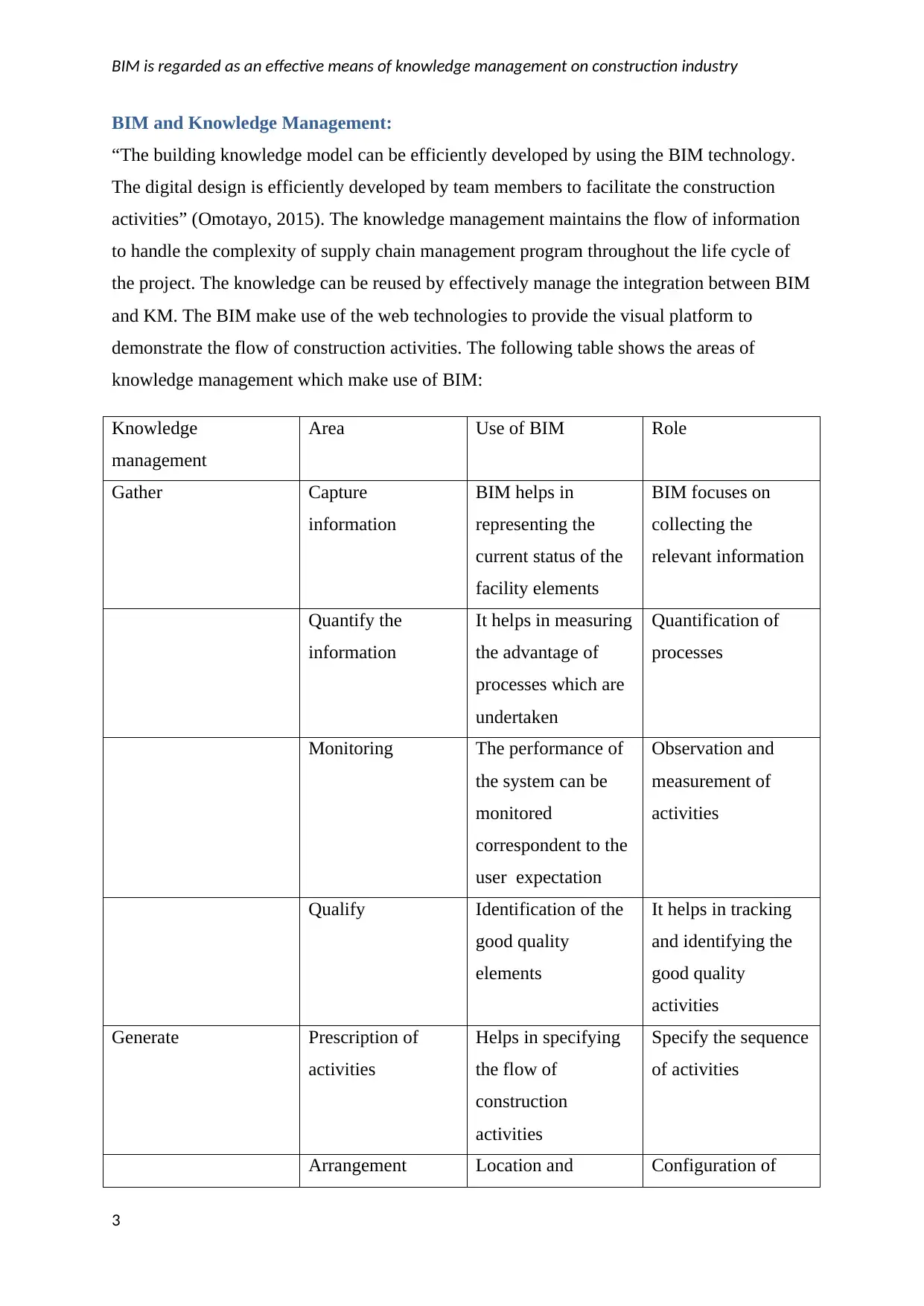
BIM is regarded as an effective means of knowledge management on construction industry
BIM and Knowledge Management:
“The building knowledge model can be efficiently developed by using the BIM technology.
The digital design is efficiently developed by team members to facilitate the construction
activities” (Omotayo, 2015). The knowledge management maintains the flow of information
to handle the complexity of supply chain management program throughout the life cycle of
the project. The knowledge can be reused by effectively manage the integration between BIM
and KM. The BIM make use of the web technologies to provide the visual platform to
demonstrate the flow of construction activities. The following table shows the areas of
knowledge management which make use of BIM:
Knowledge
management
Area Use of BIM Role
Gather Capture
information
BIM helps in
representing the
current status of the
facility elements
BIM focuses on
collecting the
relevant information
Quantify the
information
It helps in measuring
the advantage of
processes which are
undertaken
Quantification of
processes
Monitoring The performance of
the system can be
monitored
correspondent to the
user expectation
Observation and
measurement of
activities
Qualify Identification of the
good quality
elements
It helps in tracking
and identifying the
good quality
activities
Generate Prescription of
activities
Helps in specifying
the flow of
construction
activities
Specify the sequence
of activities
Arrangement Location and Configuration of
3
BIM and Knowledge Management:
“The building knowledge model can be efficiently developed by using the BIM technology.
The digital design is efficiently developed by team members to facilitate the construction
activities” (Omotayo, 2015). The knowledge management maintains the flow of information
to handle the complexity of supply chain management program throughout the life cycle of
the project. The knowledge can be reused by effectively manage the integration between BIM
and KM. The BIM make use of the web technologies to provide the visual platform to
demonstrate the flow of construction activities. The following table shows the areas of
knowledge management which make use of BIM:
Knowledge
management
Area Use of BIM Role
Gather Capture
information
BIM helps in
representing the
current status of the
facility elements
BIM focuses on
collecting the
relevant information
Quantify the
information
It helps in measuring
the advantage of
processes which are
undertaken
Quantification of
processes
Monitoring The performance of
the system can be
monitored
correspondent to the
user expectation
Observation and
measurement of
activities
Qualify Identification of the
good quality
elements
It helps in tracking
and identifying the
good quality
activities
Generate Prescription of
activities
Helps in specifying
the flow of
construction
activities
Specify the sequence
of activities
Arrangement Location and Configuration of
3
Paraphrase This Document
Need a fresh take? Get an instant paraphrase of this document with our AI Paraphraser
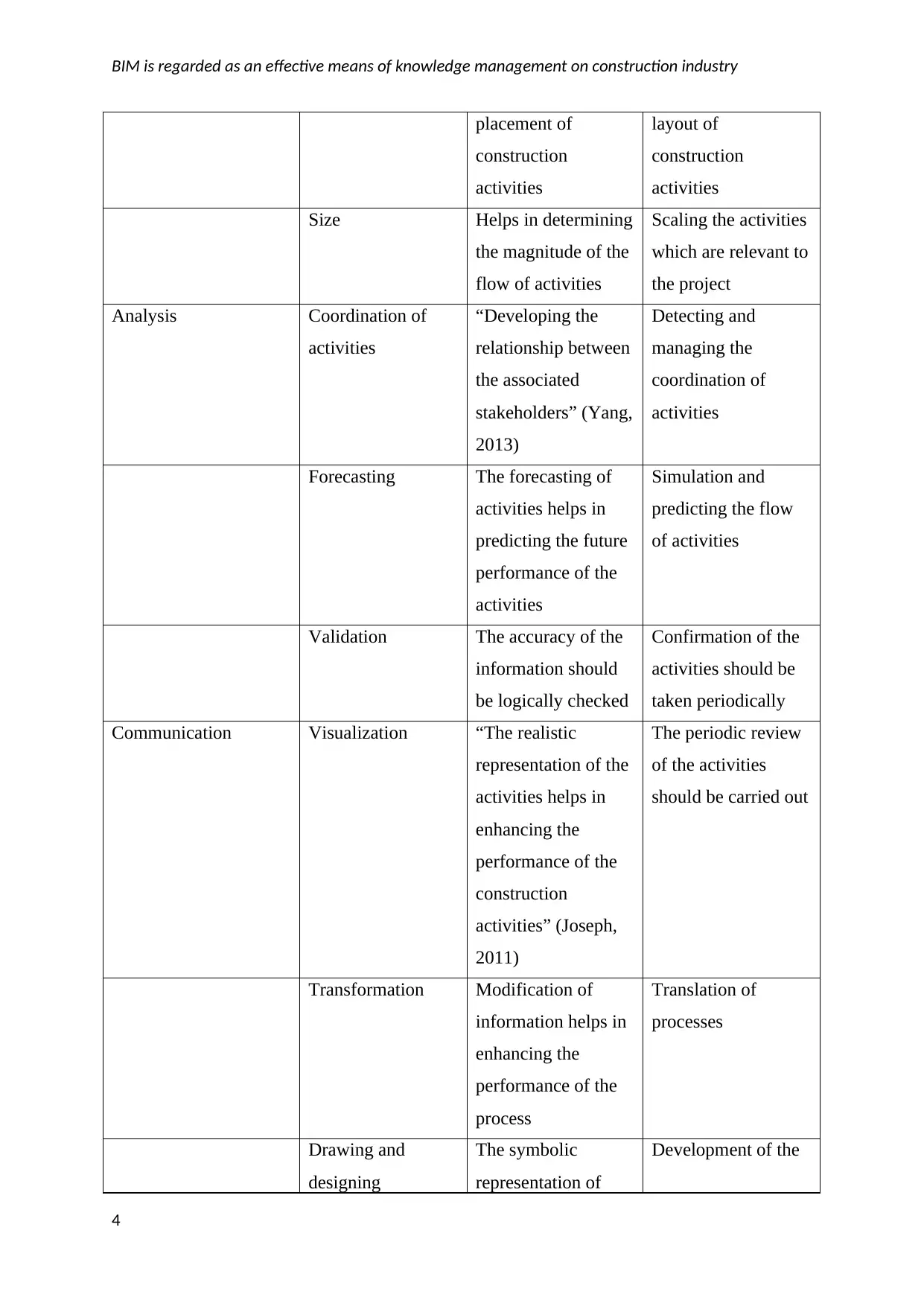
BIM is regarded as an effective means of knowledge management on construction industry
placement of
construction
activities
layout of
construction
activities
Size Helps in determining
the magnitude of the
flow of activities
Scaling the activities
which are relevant to
the project
Analysis Coordination of
activities
“Developing the
relationship between
the associated
stakeholders” (Yang,
2013)
Detecting and
managing the
coordination of
activities
Forecasting The forecasting of
activities helps in
predicting the future
performance of the
activities
Simulation and
predicting the flow
of activities
Validation The accuracy of the
information should
be logically checked
Confirmation of the
activities should be
taken periodically
Communication Visualization “The realistic
representation of the
activities helps in
enhancing the
performance of the
construction
activities” (Joseph,
2011)
The periodic review
of the activities
should be carried out
Transformation Modification of
information helps in
enhancing the
performance of the
process
Translation of
processes
Drawing and
designing
The symbolic
representation of
Development of the
4
placement of
construction
activities
layout of
construction
activities
Size Helps in determining
the magnitude of the
flow of activities
Scaling the activities
which are relevant to
the project
Analysis Coordination of
activities
“Developing the
relationship between
the associated
stakeholders” (Yang,
2013)
Detecting and
managing the
coordination of
activities
Forecasting The forecasting of
activities helps in
predicting the future
performance of the
activities
Simulation and
predicting the flow
of activities
Validation The accuracy of the
information should
be logically checked
Confirmation of the
activities should be
taken periodically
Communication Visualization “The realistic
representation of the
activities helps in
enhancing the
performance of the
construction
activities” (Joseph,
2011)
The periodic review
of the activities
should be carried out
Transformation Modification of
information helps in
enhancing the
performance of the
process
Translation of
processes
Drawing and
designing
The symbolic
representation of
Development of the
4
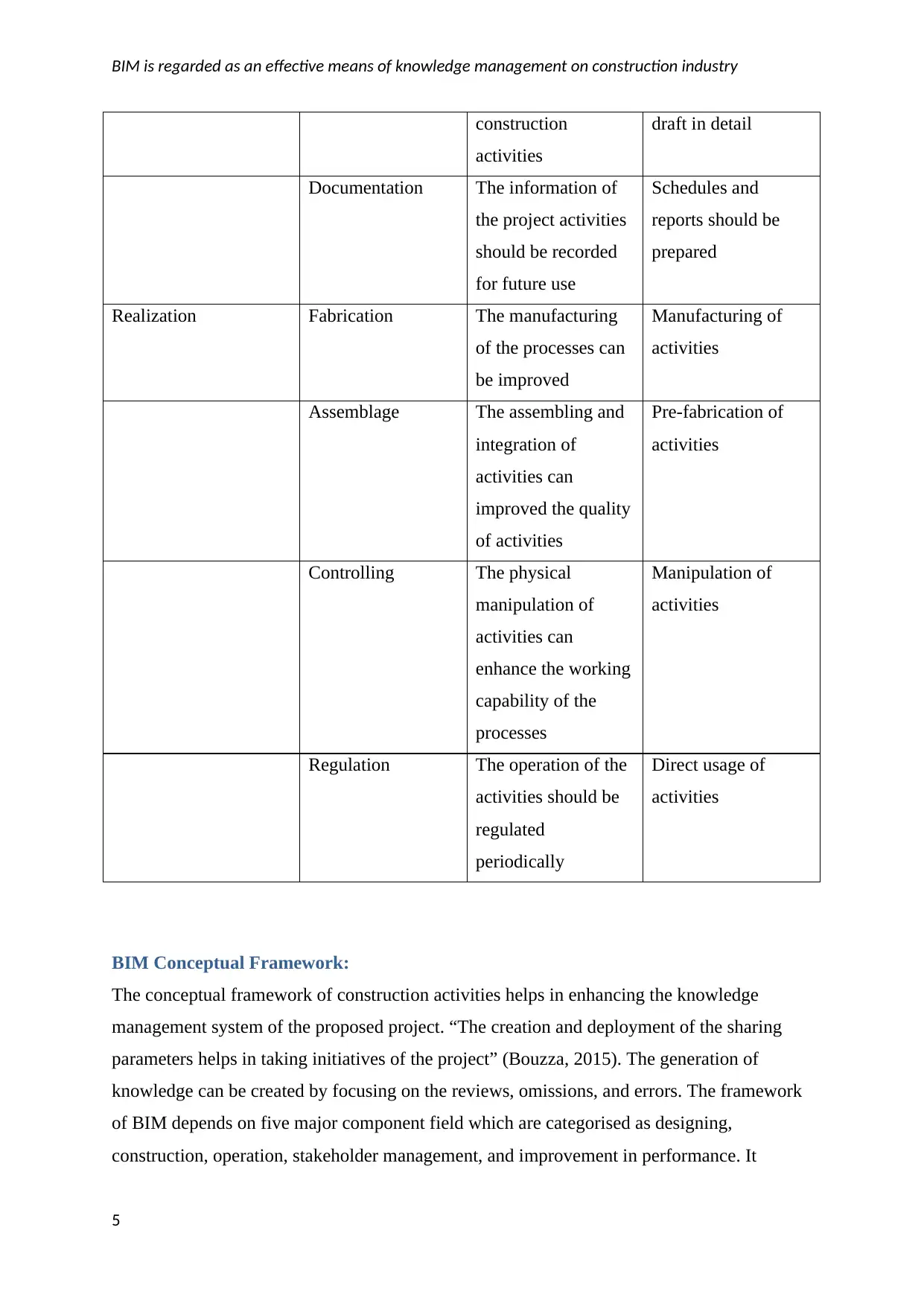
BIM is regarded as an effective means of knowledge management on construction industry
construction
activities
draft in detail
Documentation The information of
the project activities
should be recorded
for future use
Schedules and
reports should be
prepared
Realization Fabrication The manufacturing
of the processes can
be improved
Manufacturing of
activities
Assemblage The assembling and
integration of
activities can
improved the quality
of activities
Pre-fabrication of
activities
Controlling The physical
manipulation of
activities can
enhance the working
capability of the
processes
Manipulation of
activities
Regulation The operation of the
activities should be
regulated
periodically
Direct usage of
activities
BIM Conceptual Framework:
The conceptual framework of construction activities helps in enhancing the knowledge
management system of the proposed project. “The creation and deployment of the sharing
parameters helps in taking initiatives of the project” (Bouzza, 2015). The generation of
knowledge can be created by focusing on the reviews, omissions, and errors. The framework
of BIM depends on five major component field which are categorised as designing,
construction, operation, stakeholder management, and improvement in performance. It
5
construction
activities
draft in detail
Documentation The information of
the project activities
should be recorded
for future use
Schedules and
reports should be
prepared
Realization Fabrication The manufacturing
of the processes can
be improved
Manufacturing of
activities
Assemblage The assembling and
integration of
activities can
improved the quality
of activities
Pre-fabrication of
activities
Controlling The physical
manipulation of
activities can
enhance the working
capability of the
processes
Manipulation of
activities
Regulation The operation of the
activities should be
regulated
periodically
Direct usage of
activities
BIM Conceptual Framework:
The conceptual framework of construction activities helps in enhancing the knowledge
management system of the proposed project. “The creation and deployment of the sharing
parameters helps in taking initiatives of the project” (Bouzza, 2015). The generation of
knowledge can be created by focusing on the reviews, omissions, and errors. The framework
of BIM depends on five major component field which are categorised as designing,
construction, operation, stakeholder management, and improvement in performance. It
5
⊘ This is a preview!⊘
Do you want full access?
Subscribe today to unlock all pages.

Trusted by 1+ million students worldwide
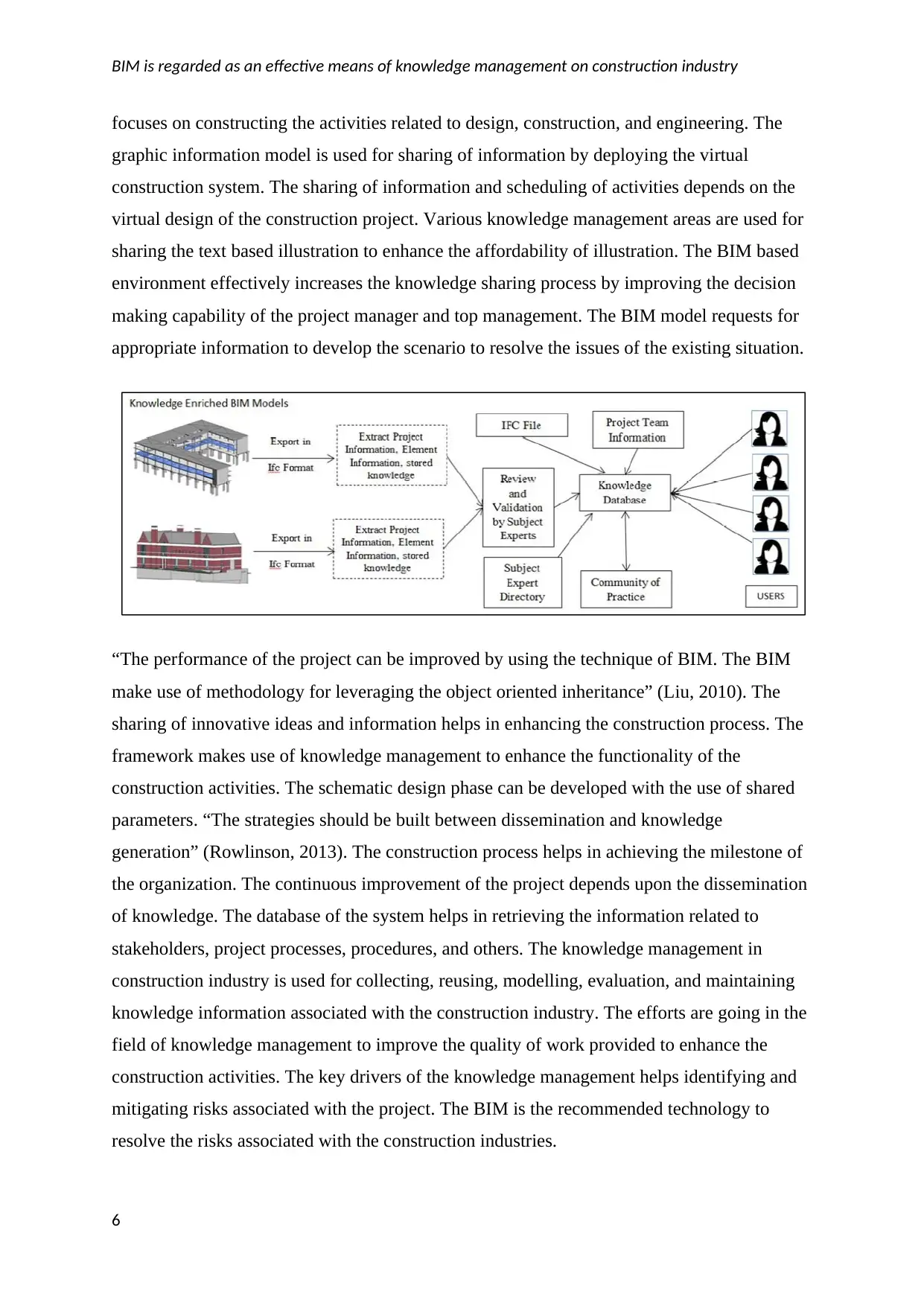
BIM is regarded as an effective means of knowledge management on construction industry
focuses on constructing the activities related to design, construction, and engineering. The
graphic information model is used for sharing of information by deploying the virtual
construction system. The sharing of information and scheduling of activities depends on the
virtual design of the construction project. Various knowledge management areas are used for
sharing the text based illustration to enhance the affordability of illustration. The BIM based
environment effectively increases the knowledge sharing process by improving the decision
making capability of the project manager and top management. The BIM model requests for
appropriate information to develop the scenario to resolve the issues of the existing situation.
“The performance of the project can be improved by using the technique of BIM. The BIM
make use of methodology for leveraging the object oriented inheritance” (Liu, 2010). The
sharing of innovative ideas and information helps in enhancing the construction process. The
framework makes use of knowledge management to enhance the functionality of the
construction activities. The schematic design phase can be developed with the use of shared
parameters. “The strategies should be built between dissemination and knowledge
generation” (Rowlinson, 2013). The construction process helps in achieving the milestone of
the organization. The continuous improvement of the project depends upon the dissemination
of knowledge. The database of the system helps in retrieving the information related to
stakeholders, project processes, procedures, and others. The knowledge management in
construction industry is used for collecting, reusing, modelling, evaluation, and maintaining
knowledge information associated with the construction industry. The efforts are going in the
field of knowledge management to improve the quality of work provided to enhance the
construction activities. The key drivers of the knowledge management helps identifying and
mitigating risks associated with the project. The BIM is the recommended technology to
resolve the risks associated with the construction industries.
6
focuses on constructing the activities related to design, construction, and engineering. The
graphic information model is used for sharing of information by deploying the virtual
construction system. The sharing of information and scheduling of activities depends on the
virtual design of the construction project. Various knowledge management areas are used for
sharing the text based illustration to enhance the affordability of illustration. The BIM based
environment effectively increases the knowledge sharing process by improving the decision
making capability of the project manager and top management. The BIM model requests for
appropriate information to develop the scenario to resolve the issues of the existing situation.
“The performance of the project can be improved by using the technique of BIM. The BIM
make use of methodology for leveraging the object oriented inheritance” (Liu, 2010). The
sharing of innovative ideas and information helps in enhancing the construction process. The
framework makes use of knowledge management to enhance the functionality of the
construction activities. The schematic design phase can be developed with the use of shared
parameters. “The strategies should be built between dissemination and knowledge
generation” (Rowlinson, 2013). The construction process helps in achieving the milestone of
the organization. The continuous improvement of the project depends upon the dissemination
of knowledge. The database of the system helps in retrieving the information related to
stakeholders, project processes, procedures, and others. The knowledge management in
construction industry is used for collecting, reusing, modelling, evaluation, and maintaining
knowledge information associated with the construction industry. The efforts are going in the
field of knowledge management to improve the quality of work provided to enhance the
construction activities. The key drivers of the knowledge management helps identifying and
mitigating risks associated with the project. The BIM is the recommended technology to
resolve the risks associated with the construction industries.
6
Paraphrase This Document
Need a fresh take? Get an instant paraphrase of this document with our AI Paraphraser
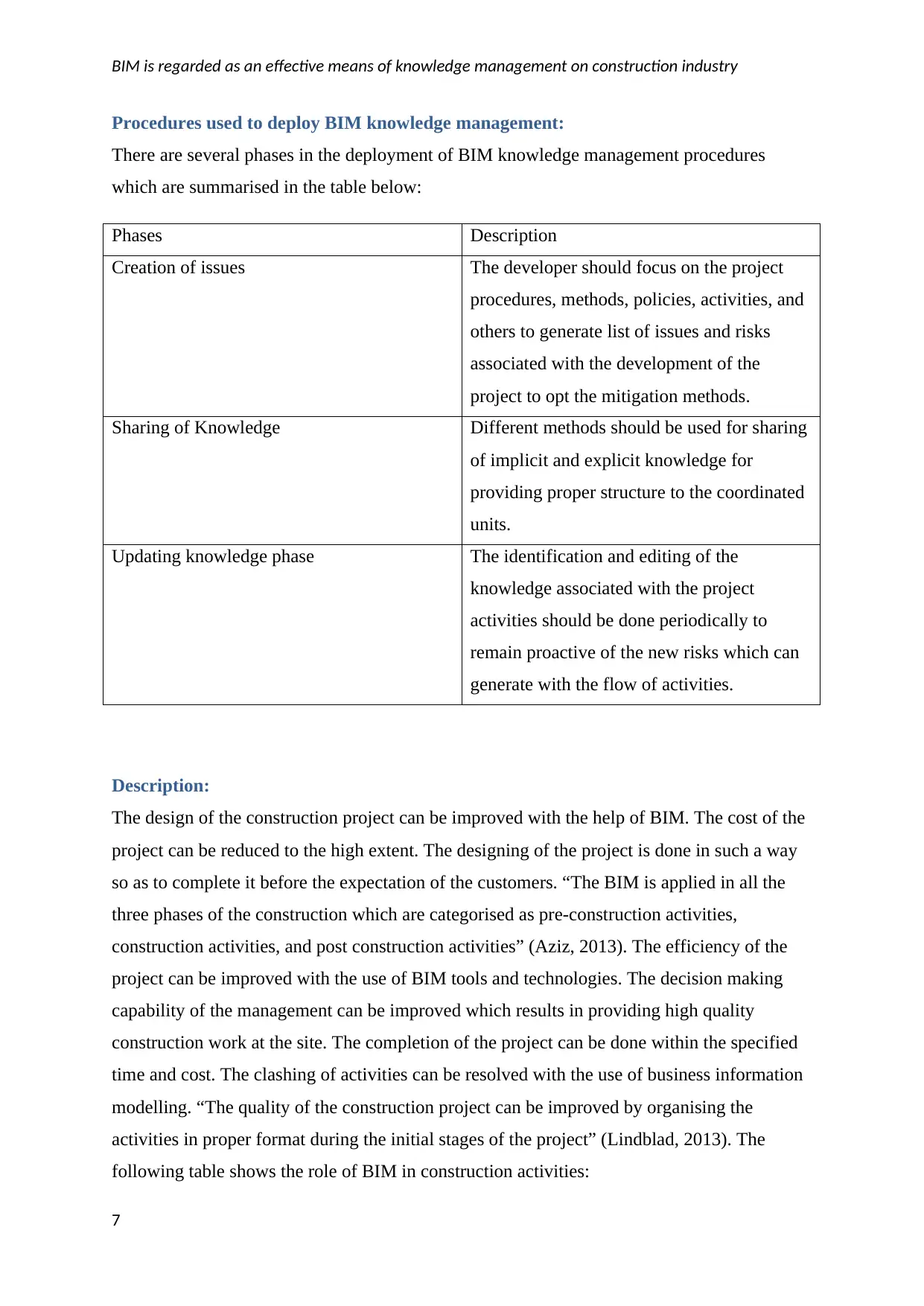
BIM is regarded as an effective means of knowledge management on construction industry
Procedures used to deploy BIM knowledge management:
There are several phases in the deployment of BIM knowledge management procedures
which are summarised in the table below:
Phases Description
Creation of issues The developer should focus on the project
procedures, methods, policies, activities, and
others to generate list of issues and risks
associated with the development of the
project to opt the mitigation methods.
Sharing of Knowledge Different methods should be used for sharing
of implicit and explicit knowledge for
providing proper structure to the coordinated
units.
Updating knowledge phase The identification and editing of the
knowledge associated with the project
activities should be done periodically to
remain proactive of the new risks which can
generate with the flow of activities.
Description:
The design of the construction project can be improved with the help of BIM. The cost of the
project can be reduced to the high extent. The designing of the project is done in such a way
so as to complete it before the expectation of the customers. “The BIM is applied in all the
three phases of the construction which are categorised as pre-construction activities,
construction activities, and post construction activities” (Aziz, 2013). The efficiency of the
project can be improved with the use of BIM tools and technologies. The decision making
capability of the management can be improved which results in providing high quality
construction work at the site. The completion of the project can be done within the specified
time and cost. The clashing of activities can be resolved with the use of business information
modelling. “The quality of the construction project can be improved by organising the
activities in proper format during the initial stages of the project” (Lindblad, 2013). The
following table shows the role of BIM in construction activities:
7
Procedures used to deploy BIM knowledge management:
There are several phases in the deployment of BIM knowledge management procedures
which are summarised in the table below:
Phases Description
Creation of issues The developer should focus on the project
procedures, methods, policies, activities, and
others to generate list of issues and risks
associated with the development of the
project to opt the mitigation methods.
Sharing of Knowledge Different methods should be used for sharing
of implicit and explicit knowledge for
providing proper structure to the coordinated
units.
Updating knowledge phase The identification and editing of the
knowledge associated with the project
activities should be done periodically to
remain proactive of the new risks which can
generate with the flow of activities.
Description:
The design of the construction project can be improved with the help of BIM. The cost of the
project can be reduced to the high extent. The designing of the project is done in such a way
so as to complete it before the expectation of the customers. “The BIM is applied in all the
three phases of the construction which are categorised as pre-construction activities,
construction activities, and post construction activities” (Aziz, 2013). The efficiency of the
project can be improved with the use of BIM tools and technologies. The decision making
capability of the management can be improved which results in providing high quality
construction work at the site. The completion of the project can be done within the specified
time and cost. The clashing of activities can be resolved with the use of business information
modelling. “The quality of the construction project can be improved by organising the
activities in proper format during the initial stages of the project” (Lindblad, 2013). The
following table shows the role of BIM in construction activities:
7
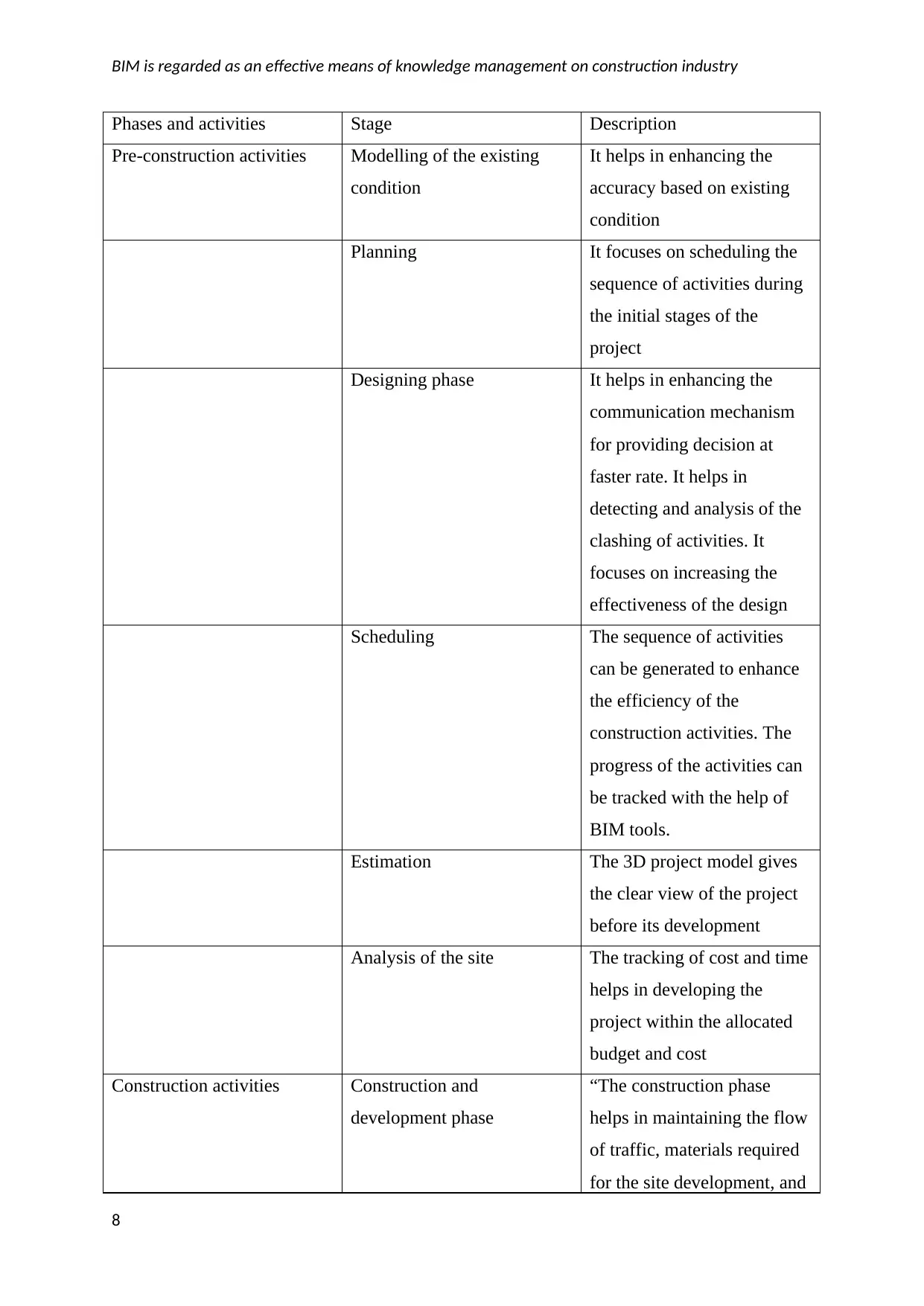
BIM is regarded as an effective means of knowledge management on construction industry
Phases and activities Stage Description
Pre-construction activities Modelling of the existing
condition
It helps in enhancing the
accuracy based on existing
condition
Planning It focuses on scheduling the
sequence of activities during
the initial stages of the
project
Designing phase It helps in enhancing the
communication mechanism
for providing decision at
faster rate. It helps in
detecting and analysis of the
clashing of activities. It
focuses on increasing the
effectiveness of the design
Scheduling The sequence of activities
can be generated to enhance
the efficiency of the
construction activities. The
progress of the activities can
be tracked with the help of
BIM tools.
Estimation The 3D project model gives
the clear view of the project
before its development
Analysis of the site The tracking of cost and time
helps in developing the
project within the allocated
budget and cost
Construction activities Construction and
development phase
“The construction phase
helps in maintaining the flow
of traffic, materials required
for the site development, and
8
Phases and activities Stage Description
Pre-construction activities Modelling of the existing
condition
It helps in enhancing the
accuracy based on existing
condition
Planning It focuses on scheduling the
sequence of activities during
the initial stages of the
project
Designing phase It helps in enhancing the
communication mechanism
for providing decision at
faster rate. It helps in
detecting and analysis of the
clashing of activities. It
focuses on increasing the
effectiveness of the design
Scheduling The sequence of activities
can be generated to enhance
the efficiency of the
construction activities. The
progress of the activities can
be tracked with the help of
BIM tools.
Estimation The 3D project model gives
the clear view of the project
before its development
Analysis of the site The tracking of cost and time
helps in developing the
project within the allocated
budget and cost
Construction activities Construction and
development phase
“The construction phase
helps in maintaining the flow
of traffic, materials required
for the site development, and
8
⊘ This is a preview!⊘
Do you want full access?
Subscribe today to unlock all pages.

Trusted by 1+ million students worldwide
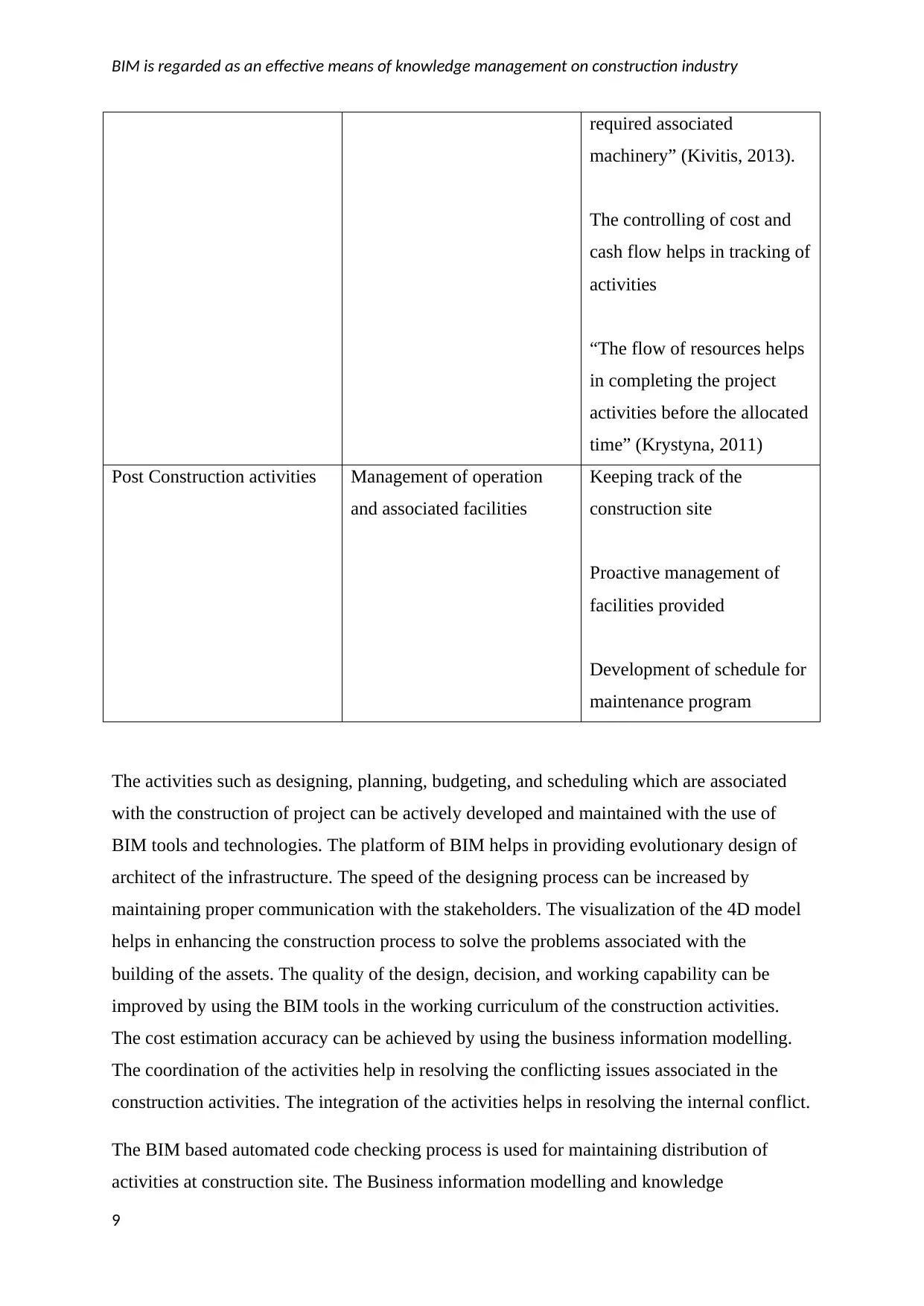
BIM is regarded as an effective means of knowledge management on construction industry
required associated
machinery” (Kivitis, 2013).
The controlling of cost and
cash flow helps in tracking of
activities
“The flow of resources helps
in completing the project
activities before the allocated
time” (Krystyna, 2011)
Post Construction activities Management of operation
and associated facilities
Keeping track of the
construction site
Proactive management of
facilities provided
Development of schedule for
maintenance program
The activities such as designing, planning, budgeting, and scheduling which are associated
with the construction of project can be actively developed and maintained with the use of
BIM tools and technologies. The platform of BIM helps in providing evolutionary design of
architect of the infrastructure. The speed of the designing process can be increased by
maintaining proper communication with the stakeholders. The visualization of the 4D model
helps in enhancing the construction process to solve the problems associated with the
building of the assets. The quality of the design, decision, and working capability can be
improved by using the BIM tools in the working curriculum of the construction activities.
The cost estimation accuracy can be achieved by using the business information modelling.
The coordination of the activities help in resolving the conflicting issues associated in the
construction activities. The integration of the activities helps in resolving the internal conflict.
The BIM based automated code checking process is used for maintaining distribution of
activities at construction site. The Business information modelling and knowledge
9
required associated
machinery” (Kivitis, 2013).
The controlling of cost and
cash flow helps in tracking of
activities
“The flow of resources helps
in completing the project
activities before the allocated
time” (Krystyna, 2011)
Post Construction activities Management of operation
and associated facilities
Keeping track of the
construction site
Proactive management of
facilities provided
Development of schedule for
maintenance program
The activities such as designing, planning, budgeting, and scheduling which are associated
with the construction of project can be actively developed and maintained with the use of
BIM tools and technologies. The platform of BIM helps in providing evolutionary design of
architect of the infrastructure. The speed of the designing process can be increased by
maintaining proper communication with the stakeholders. The visualization of the 4D model
helps in enhancing the construction process to solve the problems associated with the
building of the assets. The quality of the design, decision, and working capability can be
improved by using the BIM tools in the working curriculum of the construction activities.
The cost estimation accuracy can be achieved by using the business information modelling.
The coordination of the activities help in resolving the conflicting issues associated in the
construction activities. The integration of the activities helps in resolving the internal conflict.
The BIM based automated code checking process is used for maintaining distribution of
activities at construction site. The Business information modelling and knowledge
9
Paraphrase This Document
Need a fresh take? Get an instant paraphrase of this document with our AI Paraphraser
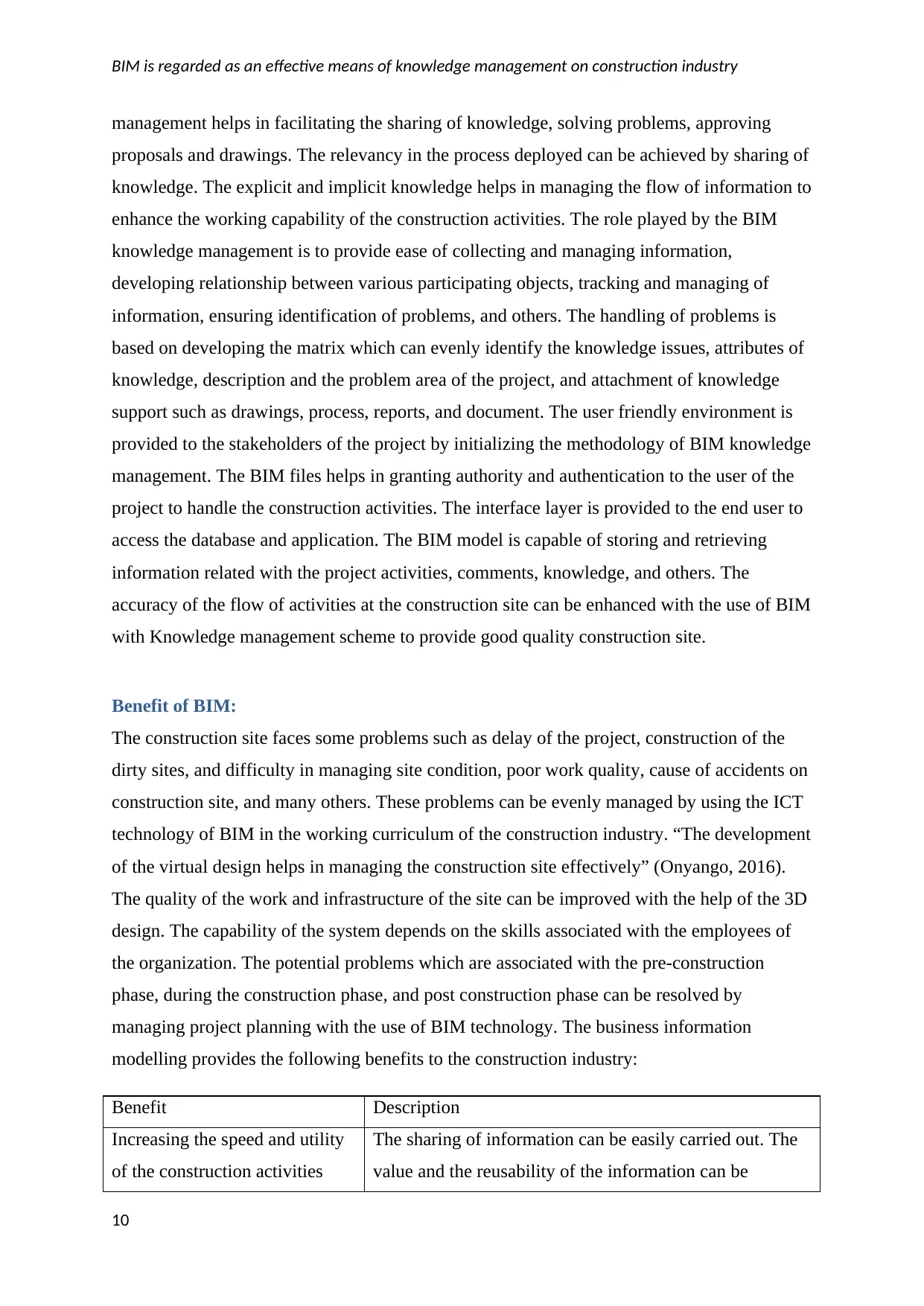
BIM is regarded as an effective means of knowledge management on construction industry
management helps in facilitating the sharing of knowledge, solving problems, approving
proposals and drawings. The relevancy in the process deployed can be achieved by sharing of
knowledge. The explicit and implicit knowledge helps in managing the flow of information to
enhance the working capability of the construction activities. The role played by the BIM
knowledge management is to provide ease of collecting and managing information,
developing relationship between various participating objects, tracking and managing of
information, ensuring identification of problems, and others. The handling of problems is
based on developing the matrix which can evenly identify the knowledge issues, attributes of
knowledge, description and the problem area of the project, and attachment of knowledge
support such as drawings, process, reports, and document. The user friendly environment is
provided to the stakeholders of the project by initializing the methodology of BIM knowledge
management. The BIM files helps in granting authority and authentication to the user of the
project to handle the construction activities. The interface layer is provided to the end user to
access the database and application. The BIM model is capable of storing and retrieving
information related with the project activities, comments, knowledge, and others. The
accuracy of the flow of activities at the construction site can be enhanced with the use of BIM
with Knowledge management scheme to provide good quality construction site.
Benefit of BIM:
The construction site faces some problems such as delay of the project, construction of the
dirty sites, and difficulty in managing site condition, poor work quality, cause of accidents on
construction site, and many others. These problems can be evenly managed by using the ICT
technology of BIM in the working curriculum of the construction industry. “The development
of the virtual design helps in managing the construction site effectively” (Onyango, 2016).
The quality of the work and infrastructure of the site can be improved with the help of the 3D
design. The capability of the system depends on the skills associated with the employees of
the organization. The potential problems which are associated with the pre-construction
phase, during the construction phase, and post construction phase can be resolved by
managing project planning with the use of BIM technology. The business information
modelling provides the following benefits to the construction industry:
Benefit Description
Increasing the speed and utility
of the construction activities
The sharing of information can be easily carried out. The
value and the reusability of the information can be
10
management helps in facilitating the sharing of knowledge, solving problems, approving
proposals and drawings. The relevancy in the process deployed can be achieved by sharing of
knowledge. The explicit and implicit knowledge helps in managing the flow of information to
enhance the working capability of the construction activities. The role played by the BIM
knowledge management is to provide ease of collecting and managing information,
developing relationship between various participating objects, tracking and managing of
information, ensuring identification of problems, and others. The handling of problems is
based on developing the matrix which can evenly identify the knowledge issues, attributes of
knowledge, description and the problem area of the project, and attachment of knowledge
support such as drawings, process, reports, and document. The user friendly environment is
provided to the stakeholders of the project by initializing the methodology of BIM knowledge
management. The BIM files helps in granting authority and authentication to the user of the
project to handle the construction activities. The interface layer is provided to the end user to
access the database and application. The BIM model is capable of storing and retrieving
information related with the project activities, comments, knowledge, and others. The
accuracy of the flow of activities at the construction site can be enhanced with the use of BIM
with Knowledge management scheme to provide good quality construction site.
Benefit of BIM:
The construction site faces some problems such as delay of the project, construction of the
dirty sites, and difficulty in managing site condition, poor work quality, cause of accidents on
construction site, and many others. These problems can be evenly managed by using the ICT
technology of BIM in the working curriculum of the construction industry. “The development
of the virtual design helps in managing the construction site effectively” (Onyango, 2016).
The quality of the work and infrastructure of the site can be improved with the help of the 3D
design. The capability of the system depends on the skills associated with the employees of
the organization. The potential problems which are associated with the pre-construction
phase, during the construction phase, and post construction phase can be resolved by
managing project planning with the use of BIM technology. The business information
modelling provides the following benefits to the construction industry:
Benefit Description
Increasing the speed and utility
of the construction activities
The sharing of information can be easily carried out. The
value and the reusability of the information can be
10
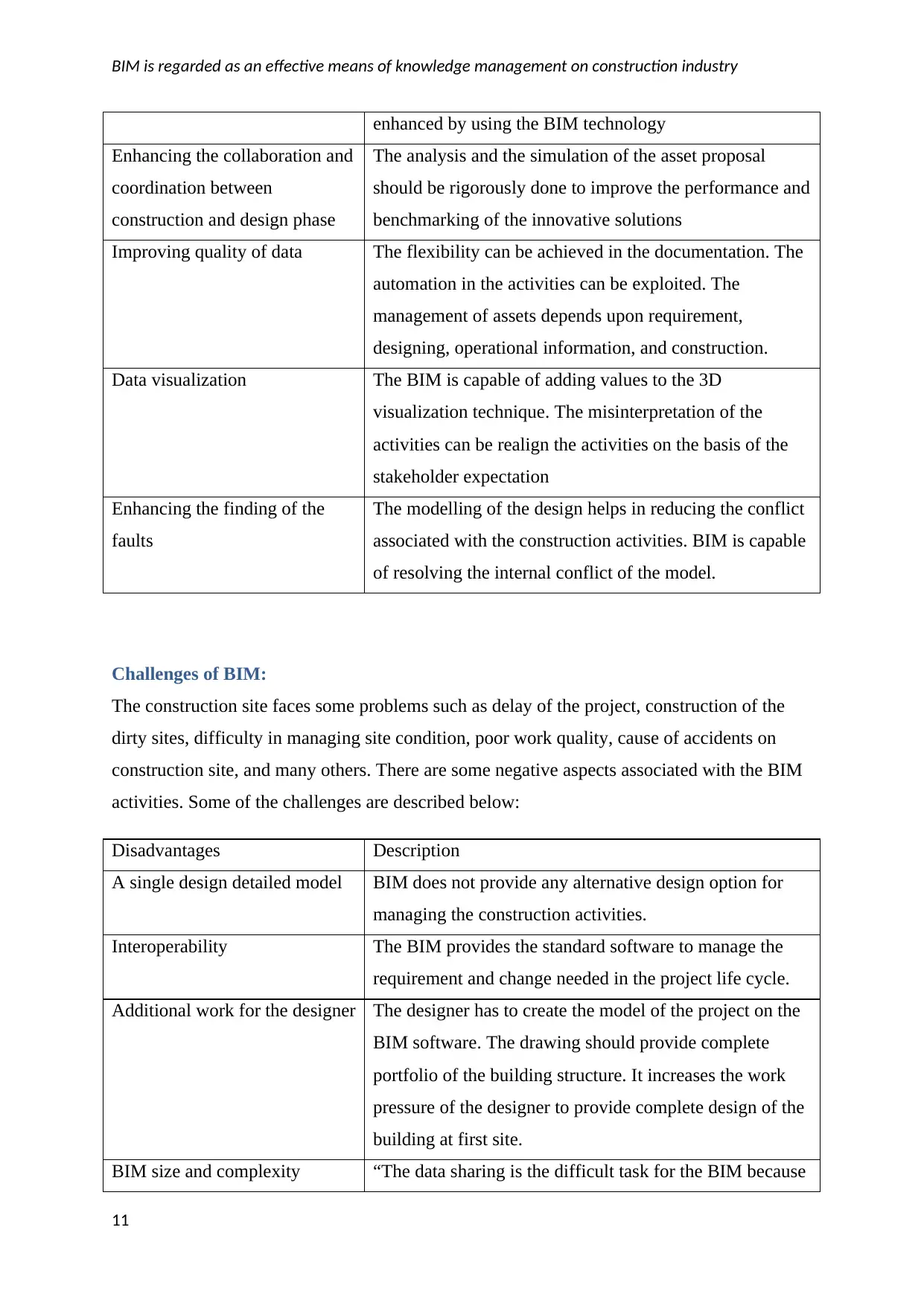
BIM is regarded as an effective means of knowledge management on construction industry
enhanced by using the BIM technology
Enhancing the collaboration and
coordination between
construction and design phase
The analysis and the simulation of the asset proposal
should be rigorously done to improve the performance and
benchmarking of the innovative solutions
Improving quality of data The flexibility can be achieved in the documentation. The
automation in the activities can be exploited. The
management of assets depends upon requirement,
designing, operational information, and construction.
Data visualization The BIM is capable of adding values to the 3D
visualization technique. The misinterpretation of the
activities can be realign the activities on the basis of the
stakeholder expectation
Enhancing the finding of the
faults
The modelling of the design helps in reducing the conflict
associated with the construction activities. BIM is capable
of resolving the internal conflict of the model.
Challenges of BIM:
The construction site faces some problems such as delay of the project, construction of the
dirty sites, difficulty in managing site condition, poor work quality, cause of accidents on
construction site, and many others. There are some negative aspects associated with the BIM
activities. Some of the challenges are described below:
Disadvantages Description
A single design detailed model BIM does not provide any alternative design option for
managing the construction activities.
Interoperability The BIM provides the standard software to manage the
requirement and change needed in the project life cycle.
Additional work for the designer The designer has to create the model of the project on the
BIM software. The drawing should provide complete
portfolio of the building structure. It increases the work
pressure of the designer to provide complete design of the
building at first site.
BIM size and complexity “The data sharing is the difficult task for the BIM because
11
enhanced by using the BIM technology
Enhancing the collaboration and
coordination between
construction and design phase
The analysis and the simulation of the asset proposal
should be rigorously done to improve the performance and
benchmarking of the innovative solutions
Improving quality of data The flexibility can be achieved in the documentation. The
automation in the activities can be exploited. The
management of assets depends upon requirement,
designing, operational information, and construction.
Data visualization The BIM is capable of adding values to the 3D
visualization technique. The misinterpretation of the
activities can be realign the activities on the basis of the
stakeholder expectation
Enhancing the finding of the
faults
The modelling of the design helps in reducing the conflict
associated with the construction activities. BIM is capable
of resolving the internal conflict of the model.
Challenges of BIM:
The construction site faces some problems such as delay of the project, construction of the
dirty sites, difficulty in managing site condition, poor work quality, cause of accidents on
construction site, and many others. There are some negative aspects associated with the BIM
activities. Some of the challenges are described below:
Disadvantages Description
A single design detailed model BIM does not provide any alternative design option for
managing the construction activities.
Interoperability The BIM provides the standard software to manage the
requirement and change needed in the project life cycle.
Additional work for the designer The designer has to create the model of the project on the
BIM software. The drawing should provide complete
portfolio of the building structure. It increases the work
pressure of the designer to provide complete design of the
building at first site.
BIM size and complexity “The data sharing is the difficult task for the BIM because
11
⊘ This is a preview!⊘
Do you want full access?
Subscribe today to unlock all pages.

Trusted by 1+ million students worldwide
1 out of 17
Related Documents
Your All-in-One AI-Powered Toolkit for Academic Success.
+13062052269
info@desklib.com
Available 24*7 on WhatsApp / Email
![[object Object]](/_next/static/media/star-bottom.7253800d.svg)
Unlock your academic potential
Copyright © 2020–2025 A2Z Services. All Rights Reserved. Developed and managed by ZUCOL.





